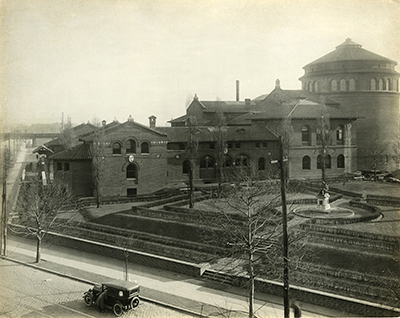An Architectural Masterpiece at the Penn Museum: the 100th Anniversary of the Harrison Rotunda
 Charles Custis Harrison, C’1862 (1844-1929) was provost of the University of Pennsylvania from 1894 to 1910 and afterwards devoted himself entirely to the Penn Museum, serving as vice-president and president of the Board of Managers until his death in 1929. He was one of the Museum’s most devoted patrons, and the Harrison Rotunda is named in his honor. Julian Russell Story (1857-1919) painted many prominent people and was regarded as a portraitist of genius. His painting of Harrison wearing academic robes (at right) was presented to the Museum by members of his family in 1955. The portrait captures Harrison’s stern yet boyish face.
Charles Custis Harrison, C’1862 (1844-1929) was provost of the University of Pennsylvania from 1894 to 1910 and afterwards devoted himself entirely to the Penn Museum, serving as vice-president and president of the Board of Managers until his death in 1929. He was one of the Museum’s most devoted patrons, and the Harrison Rotunda is named in his honor. Julian Russell Story (1857-1919) painted many prominent people and was regarded as a portraitist of genius. His painting of Harrison wearing academic robes (at right) was presented to the Museum by members of his family in 1955. The portrait captures Harrison’s stern yet boyish face.
The original design for the Penn Museum was created by a team of three prominent Philadelphia architectural firms, all of whose principals taught on the faculty of the University of Pennsylvania—Wilson Eyre, Cope & Stewardson and Frank Miles Day & Brother. Only a portion of the original plan for the Museum was built.
The first phase was completed in 1899 with public galleries, the exquisite Widener Lecture Room and a suite of laboratories and offices surrounding an Italian courtyard garden accessed through an Asian-style gate.

The Harrison Rotunda is an architectural wonder. The Guastavino engineering firm reinterpreted vernacular medieval construction methods to achieve the all-masonry rotunda, with upper and lower chambers each surmounted by a monumental self-supporting dome. On the upper level, the interlocking tile dome was topped by a glass lantern. The weight of the 90-foot walls was borne by engaged masonry piers (each side of the open arch). The floor was also 90 feet in diameter, making for harmonious proportions. The opening exhibition featured Asian ceramics in Queen Anne vitrines, with European tapestries and Oriental rugs adorning the walls and floor, all loaned for the occasion. Much of this material had appeared on the art market due to political conditions in China at the time. George Byron Gordon, museum director from 1910–1927, took advantage of the Harrison Hall opening in 1916 to encourage Museum patrons to purchase items for the permanent collections of the University Museum, as it was formally named in 1913.
The lower chamber of the Rotunda consists of an auditorium seating 800 persons. A monumental domed ceiling with a bronze sunburst at its center illuminates the Harrison Auditorium. Two features made it the talk of the town in 1915: it had a system to purify and circulate air, and masonry construction techniques permitted a pillar-free space, offering unobstructed views anywhere within the auditorium. Its small stage, however, precluded grand productions.
The Rotunda, which houses the China and Japan galleries as well as the Harrison Auditorium on the ground floor, was completed in 1915.

